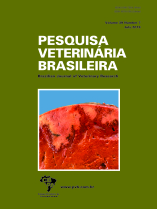 |
|
|
|
Year 2019 - Volume 39, Number 7
|

|
Spontaneous and experimental poisoning by Merremia macrocalyx (Convolvulaceae) in cattle, 39(7):447-453
|
ABSTRACT.- Brito L.B., Silva Filho G.B., Chaves H.A.S., Nascimento A.L.O., Braga T.C., Pfister J., Riet Correa F. & Mendonça F.S. 2019. Spontaneous and experimental poisoning by Merremia macrocalyx (Convolvulaceae) in cattle. [Intoxicação espontânea e experimental por Merremia macrocalyx (Convolvulaceae) em bovinos na Zona da Mata de Pernambuco.] Pesquisa Veterinária Brasileira 39(7):447-453. Laboratório de Diagnóstico Animal, Universidade Federal Rural de Pernambuco, Rua Dom Manoel de Medeiros s/n, Dois Irmãos, Recife, PE 52171-900, Brazil. E-mail: mendoncafs@yahoo.com.br
The aim of this work was to describe the epidemiological, clinical and pathological aspects of spontaneous poisoning by Merremia macrocalyx in cattle in the Pernambuco state, northeastern Brazil, and to experimentally replicate the poisoning by this plant. To determine the occurrence of poisonings, 30 farms were visited in six municipalities at the Forest Zone of Pernambuco. The plant was found in nine farms, in which history of plant poisoning in cattle, and occasionally in sheep were also reported. Three outbreaks of spontaneous poisonings in cattle were studied. To replicate the disease experimentally, two steers received a single dose of 60g/kg and two steers received 80g/kg of the fresh leaves of M. macrocalyx in the trough for spontaneous ingestion. Two steers were also used as a control group. The main clinical signs observed in spontaneous cases consisted of restlessness, bloat, polyuria, diarrhea, and death within 48 to 72 hours after the onset of clinical signs. Cattle experimentally poisoned presented similar clinical signs to those observed in spontaneous cases. Gross lesions consisted of dryness and impaction of the rumen, omasum and reticulum contents. Abomasal content was fluid, the mucosa was hyperemic, with swollen folds and multiple ulcers. Similar lesions were observed in duodenum mucosae. Histologically, lesions observed in the abomasum and duodenum mucosa consisted of necrosis, hemorrhage and inflammatory infiltration of neutrophils and lymphocytes. The wide distribution and palatability of this plant, associated with the high sensitivity of the bovine species verified in this experiment, highlight the importance of this plant in spontaneous cases of poisoning in cattle. |
| |
|
|
| |
|
 |